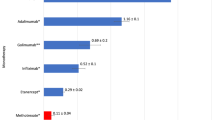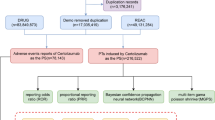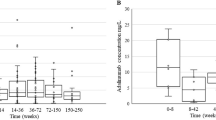Abstract
Background
Paradoxical psoriasis (PP) is a class of adverse events associated with tumor necrosis factor α inhibitor (TNFi) that are realistically observed in the real world. We aim to quantify the signals of PP with TNFis in pediatric patients based on a pharmacovigilance study.
Methods
Data on pediatric PP cases linked to five TNFi drugs—etanercept, infliximab, adalimumab, certolizumab, and golimumab—were extracted from the FDA Adverse Event Reporting System (FAERS) database (Q1 2004 to Q1 2023). PP event reports were assessed using ROR, PRR, BCPNN, MGPS, and logistic regression to conduct a disproportionality analysis and identify signal disparities.
Results
The FAERS database noted 563 pediatric PP cases, with 33.69% male and 66.31% female, representing 0.58% of all pediatric TNFi adverse event reports. The average age was 14 years. Among the five TNFis, four showed disproportionate reporting of PP: etanercept [ROR = 18.53], infliximab [ROR = 17.19], adalimumab [ROR = 10.23], and certolizumab [ROR = 3.95].
Conclusions
The real-world FAERS pharmacovigilance data showed the safety signal for PP associated with TNFi in pediatric patients. Etanercept, infliximab, adalimumab, and certolizumab showed disproportionate reporting.
Impact
-
This study collected and analysed the data of paradoxical psoriasis (PP) associated with TNFis in pediatric patients from a worldwide pharmacovigilance database.
-
Reports of PP adverse events accounted for 0.58% of the overall TNFi adverse event reports in pediatric patients.
-
Among the five TNFis, we found disproportionate reporting of PP with etanercept, infliximab, adalimumab, and certolizumab in pediatric patients.
This is a preview of subscription content, access via your institution
Access options
Subscribe to this journal
Receive 14 print issues and online access
$259.00 per year
only $18.50 per issue
Buy this article
- Purchase on SpringerLink
- Instant access to full article PDF
Prices may be subject to local taxes which are calculated during checkout

Similar content being viewed by others
Data availability
All the data generated or analyzed during this study are included in this published article and its supplementary files. TNFi reports are available and can be retrieved form the FAERS Publish Dashboard (https://www.fda.gov/drugs/questions-and-answers-fdas-adverse-event-reporting-system-faers/fda-adverse-event-reporting-system-faers-public-dashboard).
References
Aaltonen, K. J. et al. Systematic review and meta-analysis of the efficacy and safety of existing Tnf blocking agents in treatment of rheumatoid arthritis. PLoS One 7, e30275 (2012).
Conrad, C. et al. Tnf blockade induces a dysregulated type I interferon response without autoimmunity in paradoxical psoriasis. Nat. Commun. 9, 25 (2018).
Rosenwasser, N., Lee, D., Sidbury, R. & Zhao, Y. Paradoxical psoriasis in children receiving anti-Tnfalpha treatment for inflammatory/autoimmune disease. Paediatr. Drugs 23, 131–141 (2021).
Mylonas, A. & Conrad, C. Psoriasis: classical vs. paradoxical. The Yin-Yang of Tnf and type I interferon. Front. Immunol. 9, 2746 (2018).
Gattorno, M. et al. Distinct expression pattern of Ifn-alpha and Tnf-alpha in juvenile idiopathic arthritis synovial tissue. Rheumatology46, 657–665 (2007).
Seneschal, J. et al. Cytokine imbalance with increased production of interferon-alpha in psoriasiform eruptions associated with antitumour necrosis factor-alpha treatments. Br. J. Dermatol 161, 1081–1088 (2009).
Maronese, C. A., Costanzo, A., Gilliet, M. & Marzano, A. V. Paradoxical psoriasis: from its many faces to possible shared therapeutic targets. J. Invest. Dermatol. 144, 2084–2085 (2024).
Cleynen, I. et al. Characteristics of skin lesions associated with anti-tumor necrosis factor therapy in patients with inflammatory bowel disease: a cohort study. Ann. Intern. Med. 164, 10–22 (2016).
Freling, E. et al. Cumulative incidence of, risk factors for, and outcome of dermatological complications of anti-Tnf therapy in inflammatory bowel disease: a 14-year experience. Am. J. Gastroenterol. 110, 1186–1196 (2015).
Hauben, M., Madigan, D., Gerrits, C. M., Walsh, L. & Van Puijenbroek, E. P. The role of data mining in pharmacovigilance. Expert Opin. Drug Saf. 4, 929–948 (2005).
Noren, G. N., Bate, A., Orre, R. & Edwards, I. R. Extending the methods used to screen the who drug safety database towards analysis of complex associations and improved accuracy for rare events. Stat. Med. 25, 3740–3757 (2006).
Szarfman, A., Machado, S. G. & O’Neill, R. T. Use of screening algorithms and computer systems to efficiently signal higher-than-expected combinations of drugs and events in the Us Fda’s spontaneous reports database. Drug Saf. 25, 381–392 (2002).
Tieu, C. & Breder, C. D. A critical evaluation of safety signal analysis using algorithmic standardised MedDRA queries. Drug Saf. 41, 1375–1385 (2018).
Bate, A. & Evans, S. J. Quantitative signal detection using spontaneous Adr reporting. Pharmacoepidemiol. Drug Saf. 18, 427–436 (2009).
Kip, K. E. et al. Tumor necrosis factor alpha antagonist-associated psoriasis in inflammatory diseases: an analysis of the Fda adverse event reporting system. Inflamm. Bowel Dis. 19, 1164–1172 (2013).
Eickstaedt, J. et al. Paradoxical psoriasiform eruptions in children receiving tumor necrosis factor alpha inhibitors. JAMA Dermatol 159, 637–642 (2023).
Harrison, M. J. et al. Rates of new-onset psoriasis in patients with rheumatoid arthritis receiving anti-tumour necrosis factor alpha therapy: results from the British Society for Rheumatology Biologics Register. Ann. Rheum. Dis. 68, 209–215 (2009).
Havmose, M. & Thomsen, S. F. Development of paradoxical inflammatory disorders during treatment of psoriasis with Tnf inhibitors: a review of published cases. Int J. Dermatol 56, 1087–1102 (2017).
Buckley, L. H., Xiao, R., Perman, M. J., Grossman, A. B. & Weiss, P. F. Psoriasis associated with tumor necrosis factor inhibitors in children with inflammatory diseases. Arthritis Care Res.73, 215–220 (2021).
Eickstaedt, J. B. et al. Psoriasis and psoriasiform eruptions in pediatric patients with inflammatory bowel disease treated with anti-tumor necrosis factor alpha agents. Pediatr. Dermatol. 34, 253–260 (2017).
Romiti, R., Araujo, K. M., Steinwurz, F. & Denadai, R. Anti-tumor necrosis factor alpha-related psoriatic lesions in children with inflammatory bowel disease: case report and systematic literature review. Pediatr. Dermatol. 33, e174–e178 (2016).
Acknowledgements
We thank the investigators and institutions involved in this study. This work was supported in part by the National Key R&D Program of China (2021YFC2702005, 2022YFC2703100, 2023YFC2706101), Beijing Hospitals Authority’s Ascent Plan (DFL20221001), Beijing Municipal Hospital Scientific Research and Cultivation Program (PX2023043), and Tianchi Talent Program of Xinjiang Uygur Autonomous Region.
Author information
Authors and Affiliations
Contributions
Y.P. and X.X. performed the study and analyzed the data. X.X. wrote the manuscript. X.Y. carried out the collection of resources. Y.L. surveyed the relevant literature. Y.S. performed methodological support. X.W. and T.H. were responsible for issuing and collecting scales. H.M. conceived and guided the study and critically revised the manuscript. All authors contributed to the article and approved the final manuscript.
Corresponding author
Ethics declarations
Competing interests
The authors declare no competing interests.
Ethics approval
Since the FAERS database is accessible to the public and patient records are anonymized and deidentified, ethical clearance and informed consent are not required for this study.
Additional information
Publisher’s note Springer Nature remains neutral with regard to jurisdictional claims in published maps and institutional affiliations.
Rights and permissions
Springer Nature or its licensor (e.g. a society or other partner) holds exclusive rights to this article under a publishing agreement with the author(s) or other rightsholder(s); author self-archiving of the accepted manuscript version of this article is solely governed by the terms of such publishing agreement and applicable law.
About this article
Cite this article
Piao, Y., Xu, X., Yao, X. et al. Paradoxical psoriasis in pediatric tumor necrosis factor-α inhibitor therapy database. Pediatr Res (2025). https://doi.org/10.1038/s41390-025-04305-5
Received:
Revised:
Accepted:
Published:
DOI: https://doi.org/10.1038/s41390-025-04305-5



